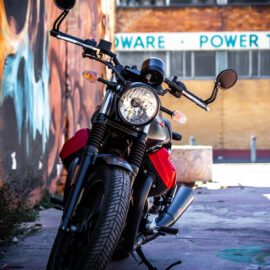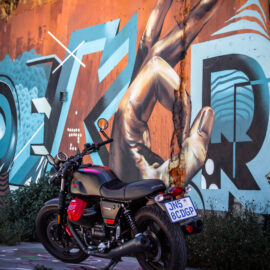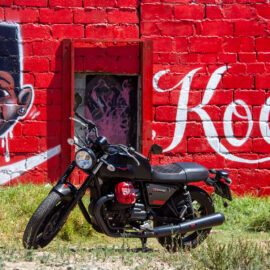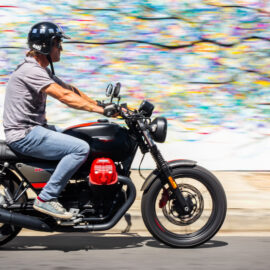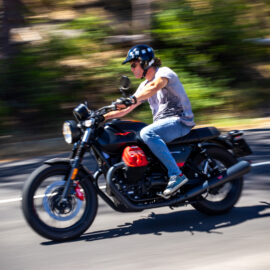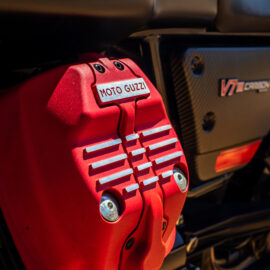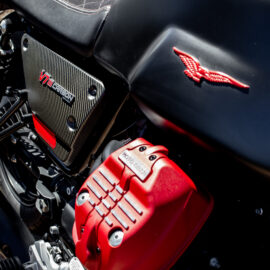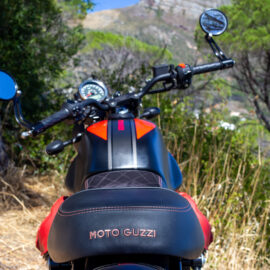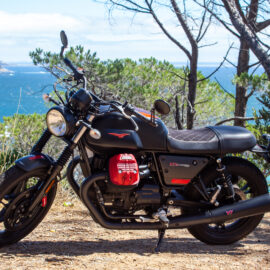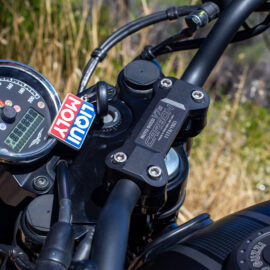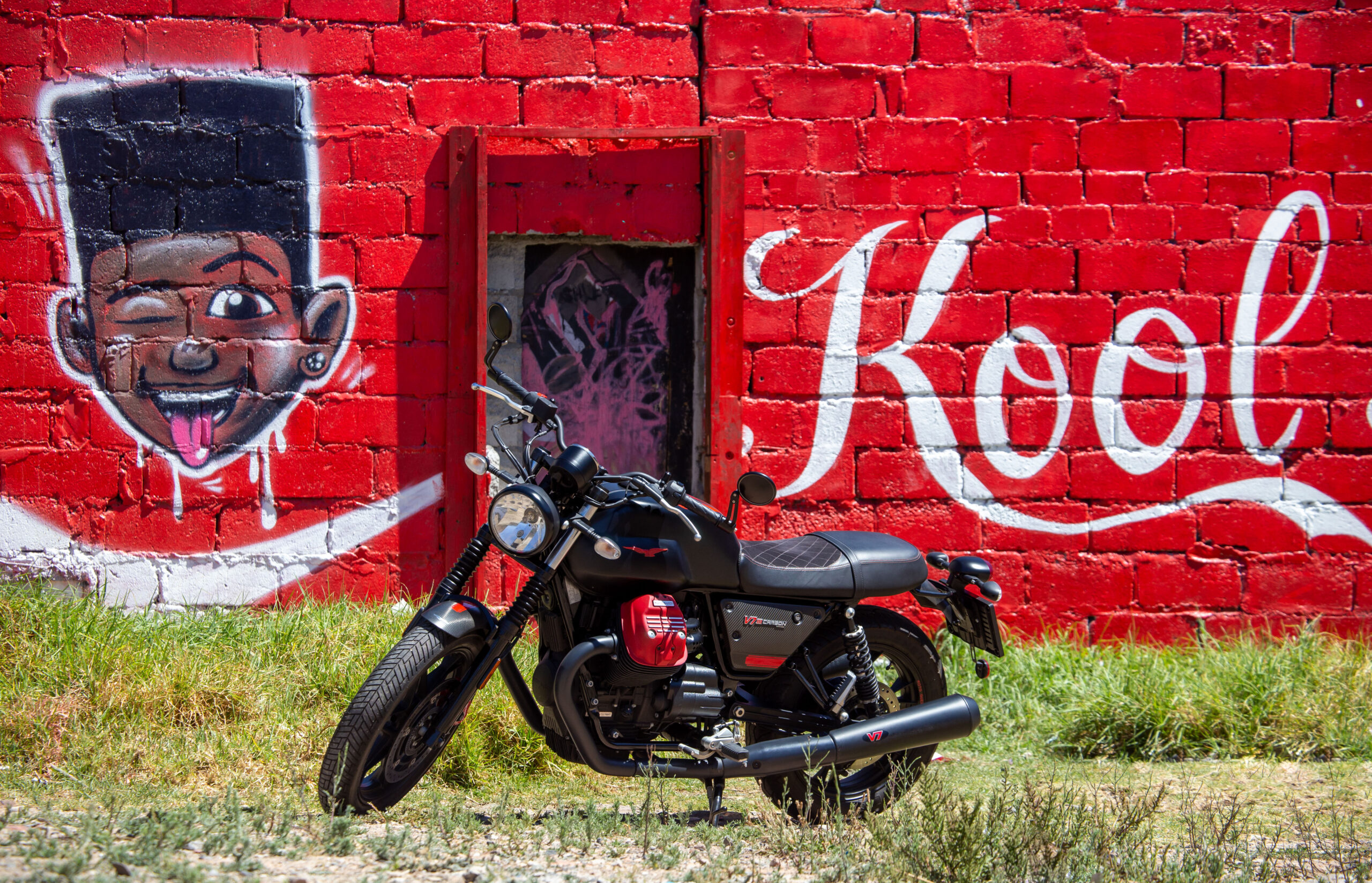
25 Feb On Yer Bike: Moto Guzzi
FMM Curator Wayne Harley wishes Moto Guzzi a happy 100th birthday…
A century on, it’s fantastic to know that Moto Guzzi is still going strong. Giovanni Ravelli, Giorgio Parodi and Carlo Guzzi were the three gents behind Moto Guzzi’s creation while all were serving in the Corpo Aeronautico Militare (the Italian Air Corp, CAM) during WW1. Sadly, Ravelli, a fighter pilot and motorcycle racer, lost his life days after the war ended while undertaking a test flight. This left his partners to establish Società Anonima Moto Guzzi on 15 March 1921, legally based in Genoa, but with headquarters at Mandello del Lario in the province of Lecco, in Lombardy, on Lake Como. In honour of Ravelli’s service to the Italian Air Force, Parodi and Guzzi adopted the eagle motif of the Italian Air Force as the logo for Moto Guzzi.
The first motorcycles were named GP (Guzzi-Parodi), though the marque quickly changed to Moto Guzzi.to avoid confusion of the name with Giorgio Parodi’s initials. Although Parodi and Guzzi were equal partners, the change was believed to be due to the Parodi family requesting that their name did not get used on, or be associated with, motorcycle production because of their many other business interests.
The first motorcycle was a fine 493cc machine simple known as the ‘Normale’ designed by Carlo Guzzi, of which 2 065 were produced in 1921. The company soon followed up with 246cc ohc single, and then in 1926 a 499cc ohv, which was a stunningly beautiful and sporty machine presented in burgundy with gold trim and logo. The engine produced 18hp (13,4kW) and the bike had an impressive top speed of 100 km/h. In that same year, Moto Guzzi also produced a very successful 499cc ohc racing bike along with many other prototype racing machines. Two years later the GT 500 was launched, but subsequently re-named the Norge after Carlo Guzzi’s epic ride to the Arctic Circle on a Moto Guzzi. More important is the fact that the Norge was also the first mass-produced motorcycle with a rear suspension. Over the next 22 years the Norge was followed up by other wonderful machines such as the Airone, Cardellino, Fallcone and Galletto, but back to the early days….
By 1932 Moto Guzzi had already started experimenting with 3- and 4-cylinder engines for a motor sport programme, but it would be the 1933 120-deg V-twin that would form the backbone of Moto Guzzi’s racing line-up for most of the next two decades. However, a 3-cylinder supercharged 499cc Moto Guzzi known as the Gambalunghino was also campaigned very successfully in the years leading up to WW2. In 1953 the company campaigned a 4-cylinder dohc water-cooled racer, and two years later an amazing and totally revolutionary V8 dohc water-cooled machine. In 1957, after racking up eight world and six constructors’ championship titles as well as 11 wins at the Isle of Man, Moto Guzzi surprisingly shut down its motor sport division.
Production continued of the mainly smaller production motorcycles and scooter-like designs. However, in 1969 the new Giulio Cesare Carcano-designed V7 engine saw the light of day. This engine was primarily a 748cc ohv twin mounted transversely to a 5-speed gearbox and shaft drive, which was to become Moto Guzzi’s trademark combination for the next 52 years. It did receive an upgrade in the late 70s by Lino Tonti, but the basics remained relatively unchanged. The engine would later become available from 350 to as much as 1100cc, and was offered in memorable motorcycles including the Le Mans, California and Monza.
But like so many motorcycle names in history, financial troubles threatened Moto Guzzi’s closure. Fortunately, in February 1967 SEIMM (Società Esercizio Industrie Moto Meccaniche) stepped in and rescued the company, but it was also thanks to the likes of De Tomaso, Aprilia and, finally, Piaggio that over the years the flame at Moto Guzzi has never gone out. Fast forward to 2021 and on March 15 we will see Moto Guzzi celebrating 100 years of fantastic motorcycles, joining such brands as Benelli, Triumph, Harley-Davidson, Indian and Garelli amongst the oldest names in motorcycle world history.
To celebrate its centenary, Moto Guzzi released a number of limited edition motorcycles in 2020 and again this year. In mid-February I was fortunate enough to get a 2020 V7 Carbon Limited Edition for a weekend to test ride in anticipation and honour of the company’s milestone. The Carbon Edition is unmistakably Moto Guzzi with elegant and clean retro styling. It is powered by an uprated – but still very recognisable – V7 transverse V-twin 750cc engine producing 38kW at 6200 r/min, which I did find a little disappointing, but the sound and engine torque twist is so recognisable.
Riding this bike immediately transported me to my first encounter with a Moto Guzzi back in the late 1990s. The new bike is lighter and slightly smaller than most modern bikes, on par with the BMW RnineT I tested in 2019. The ride and feel are truly retro and was oh so much fun and true to classic motorcycling. As I stated earlier, the motorcycle presents clean, plain and uncluttered styling, and is nice and simple to understand. Handling is rock solid, with easily manageable performance; I would recommend it to anyone as a first time buy in retro-style motorcycling.
The 6-speed gearbox operates smoothly but I found the gearing a little short, and you are ‘asked’ to change up by an annoying flashing red light on the single instrument cluster. With peak torque of 60N.m at 4600 r/min, the bike does pull rather well in top gear, though, so you can easily cruise around in fifth and sixth gears, even at low engine speeds. But twist her ear in the top gears and the Moto Guzzi will pick up and go. To stop the go, Brembo ABS brakes are fitted as standard to a linked braking system that is something Moto Guzzis have had since the 1980s. The system comprises a single disc with a four-pot caliper on the front wheel, and a single disc with a two-pot caliper on the back wheel. The result is that braking is very good and precise.
A tubular double-cradle type frame is retained with 40mm hydraulic forks at the front and twin-spring pre-adjustable shocks at the back. Nothing special in that department but the set-up gets the job done and just looks so awesome and spot-on retro! What has been upgraded is the engine that is now fed by Weber Marelli fuel injection. I found the motorcycle very light on fuel – Moto Guzzi claim about 18km/litre (5,55 l/100km) and I got closer to 19km/litre (5,25l/100km).
At the end of my weekend with this wonderful little Italian time machine, I was sorry to have to give it back. As a retro bike it did transport me back 35 years, not only in looks but also in the classic riding sensation. But would I use it as my daily?
No. But I wouldn’t mind having one in my garage just to enjoy a weekend retro cruise as it has true Italian panache and brought a massive smile to my face…




